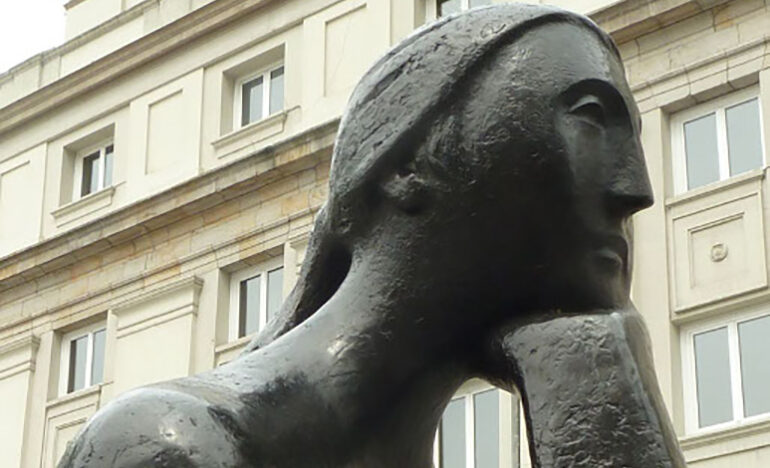Contemplative Prayer: The Five Steps of Lectio Divina

By Kathy Keary
In our series, An Invitation to Something New, contemplation has been described as the awareness and attention to all of life through which we discover the embrace of God’s love. But how do we become people who embrace the reality that all of life and creation are sacred? How do we come to see the world as sacramental — as a doorway to the sacred — as divinity itself? The practice of meditative prayer opens our hearts to communion with the indwelling spirit of God that over time fosters what Thomas Merton called “life itself, fully awake, fully aware that it is alive … a spontaneous awe at the sacredness of life, of being.”
For the next several weeks, we will delve into various types of meditative prayer as a contemplative practice. We will begin with Lectio Divina (pronounced lex-ee-o di-veen-a), sacred reading, an ancient practice in which one listens for God’s voice in Scripture. This practice dates back to the early Church, was enjoyed by the desert mothers and fathers, and was included in St. Benedict’s Rule in the sixth century. It continues today to open hearts to the Holy One through the Sacred Word. Henri Nouwen in his book, Spiritual Formation, speaks of this practice:
Lectio divina means to read the Bible with reverence and openness to what the Spirit is saying to us in the present moment. When we approach the Word of God as a word spoken to me, God’s presence and will can be made known. The regular practice of lectio divina presents occasions when my story and God’s story meet, and in that moment something surprising can happen. To read the Bible in this way means therefore to read “on my knees” reverently, attentively, and with the deep faith that God has a word for me in my own unique situation.
Lectio Divina consists of five steps.
Step 1
Select a Scripture passage upon which to reflect. It could be the reading for the day or you might choose to engage in this practice with a certain book of the Bible savoring brief parts of it each day. As we discuss the various steps, you are invited to use the following passage, Isaiah 55:1-3a:
All you who are thirsty,
come to the water!
You who have no money,
come, buy grain and eat;
Come, buy grain without money,
wine and milk without cost!
Why spend your money for what is not bread;
your wages for what does not satisfy?
Only listen to me, and you shall eat well,
you shall delight in rich fare.
Pay attention and come to me;
listen, that you may have life.
It is important to set the stage for deep reflection by preparing your heart to relish the Word of God. Relax. Perhaps focus on your breathing. Breathe in God’s love. Breathe out any distractions that will prevent you from fully participating in this sacred practice.
Step 2
Read the passage — preferably out loud — two or three times. The first time, just get a feel for the passage. When you read the passage a second time, note the word or phrase to which your attention is being drawn. It is God drawing your attention to this word or phrase. The divine has a special message just for you in this moment. If nothing stood out to you, read the passage a third time. Sometimes a word stands out as clear as a bell while at other times the experience may be more subtle.
Step 3
Meditate on the word or phrase that stood out to you. How is God speaking to you through this word or phrase? Is there an invitation? Is there a call? Does a memory surface? What image comes to mind? What feelings are evoked? Take your time and allow God to speak to you in the depths of your soul. Notice that God is speaking to you personally about your life right now.
Step 4
Respond to God who has been speaking to you. What is your response? What is your prayer? Allow your words to come from a place deep within where the Spirit dwells.
Step 5
Still yourself and rest in the loving embrace of your Maker. Words are never sufficient to express all that stirs within. Simply be present to the Sacred One. Savor the silence. Connect with the Presence deep in your soul.
I find that journaling enhances my experience as I savor the sacred text. Writing the word or phrase that stood out to you on a little card and placing it where you will see it throughout the day will allow you to continue your reflection and center your day on the message contained in these hallowed words. A review of these cards over time may surface a broader message.
Stay tuned for our next reflection on the meditative practice of Visio Divina, sacred seeing. It is similar to Lectio Divina, but art is the subject of reflection. Over time meditative practices open our hearts to experience the divine in all of life.
Note: New articles in this series will be posted to the website every Monday and Wednesday. Full series can be found here: An Invitation to Something New: The Contemplative Life. On Thursday’s we’ll send an email to remind you of the articles.
[Kathy Keary, a Precious Blood Companion and spiritual director, holds a master’s degree in theological studies and is a graduate of the Atchison Benedictine’s Sophia Center’s Souljourners Program, an intense study of spirituality and spiritual direction. Kathy believes that the divine is present and active in all of life and encourages others to be awakened to the God in all including the divine within. She enjoys accompanying others on their journey to wholeness discovering the person they were created to be.]
Image above is By Nacho. CC BY 2.0. It is “la Pensadora” by José Luis Fernández in Oviedo, Asturias, Spain.
Related

Take Nothing for the Journey
An Assembling God’s Puzzle video
By Fr. Garry Richmeier, C.PP.S.
Jesus’ teaching about what to take on a journey — nothing — is actually good advice for building trusting relationships. Don’t bring your “stuff” into the relationship; listen deeply and respec their views and situation, understand their struggles.

Pilgrims of Hope, Episode 6: Walking with Cancer Survivors
Hosted by Fr. Ron Will, C.PP.S.
We are talking with people who find hope amid difficult circumstances or bring hope to others. In this episode, Kathy Keary talks about how centering prayer, journaling and other spiritual practices helped her cope with two life threatening health issues.
Categories
Assembling God's Puzzle Coffee with Padre Cooking & Spirituality Encounters of the 4th Kind Family Matters Reflections on the Eucharsitic Prayers Spiritual Resources Taize Prayers The Contemplative Life Traveling with Pilgrims of Hope Uncategorized Videos Week of Prayer for Uhristian Unity When you need a little help
